Artists, Musicians, Entertainers and Photographers
Who Were Customers, 1855 Through the Early 1900s
While Pittsburgh was best-known as an industrial town in the late 1800s and early 1900s, many artists, musicians and others working in creative fields made the city their home during the era of steel mills and smoke stacks.
The Scalp Level School of painters was born and thrived in Southwestern Pennsylvania. The city's symphony orchestra grew and flourished thanks to a robust community of talented musicians, many with classical training in Europe's finest music academies. Theatrical professionals provided entertainment in a downtown bustling with business travelers, local merchants and their customers.
Read about some of Dollar Bank's early depositors who were part of Pittsburgh's arts and entertainment scene back when the city was busy forging the steel that built a nation.
Artists
August Wendt and Giacomo Rosa were fresco painters. Italian immigrant Giacomo Rosa (1871 savings account) worked in churches, painting religious-themed murals.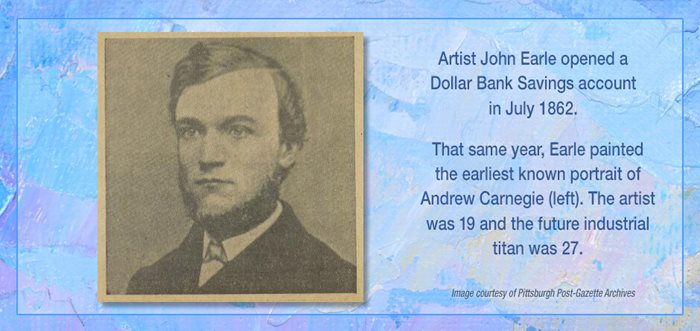
August Wendt, a German immigrant, opened a savings account with Dollar Bank in 1893. Shortly after that, he moved to St. Louis, where he opened his own interior decorating shop, specializing in wallpaper and fresco paintings. Wendt created decorative paintings inside homes and churches.
Jules A. Burgun (1880 savings account) was a Belgian glass decorator who worked for many years at Charles Reizenstein’s china and glassware firm. Glass engraver Edward Marschner (1880) was born in Germany.
Architectural sculptor Arthur Albert Raison (1891), an English immigrant, was also a deaf-mute. Metal sculptor Raimund Yanda (1893), born in France, designed a carousel for a local amusement company.
Artist and illustrator Pierre W. Paulin listed his occupation as “glass designer” when he opened a savings account at Dollar Bank in June 1910. Born on the North Side, Paulin attended Pittsburgh’s Stevenson Art School and the Academy of Fine Arts in Philadelphia. In 1915, he was awarded the Hewlett Memorial Art Fellowship from the Design School at the Carnegie Institute of Technology. His brother, Victor Philip Paulin, was the president of Whipple Art Glass Company in Cleveland.
Susan Irwin Haymaker’s savings account was opened in trust for her (along with one for her younger sister, Marion) in June 1885, by family friend Morris S. Nemer, a civil engineer. The Haymaker girls’ father, Obadiah, had been killed in a gas well riot in Westmoreland County in 1883, leaving his widow, Ann, with five young children to care for.

Susan Irwin Haymaker was one of 20 female artists whose works were displayed at the Carnegie Art Institute’s exhibition in 1910. Earlier that year, she sold one of her watercolors, “Lighthouse at Gragiot Point, Lake Erie,” at the first Associated Artists’ Exhibition, held at the Grand Opera House. In 1912, she took a trip to Europe, sketching the cities of Antwerp and Bruges.
Haymaker shared a studio with artist Mary Ethel McAuley in the McCance Building at the corner of Seventh and Smithfield Streets. Haymaker and McAuley were part an experimental group of female painters, all Pittsburghers. The Joseph Horne Co. hosted an exhibit of their paintings in 1913. Haymaker later moved to New York City and, in 1926, married Josef Lenhard, a Czech painter and illustrator.
Other painters who opened accounts with Dollar Bank were Jennie E. Chambers (1877), John R. Bowes (1893), Alonzo B. DeLo (1898), Emory Ellsworth Synder of Nebraska (1912), and French-Canadian immigrant Ida Didier (1898), who gave French lessons to supplement her income as an artist.
Rawsthorne Bros., a printing and engraving firm, was founded in Pittsburgh in the 1880s by a family of immigrant engravers. The Rawsthornes left Manchester, England in 1879 and settled in Pittsburgh. Robert Rawsthorne, Sr. became a Dollar Bank customer in 1900, as did his sons Robert Rawsthorne, Jr. (1890) and Edwin (1920). Another son, Leonard, joined his father and brothers in the United States 1883.
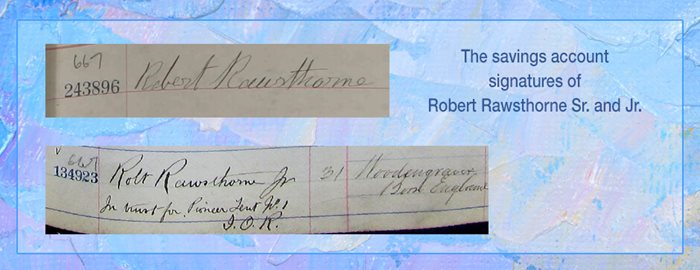
In Pittsburgh, the Rawsthornes ran several family-owned businesses in the fields of printing, engraving, and commercial art and illustration. From wood engraving, the traditional family skill, they expanded into photo engraving, electrotyping, and halftone and zinc cuts. On-staff illustrators included Leonard’s son, John W. Rawsthorne. (He headed Stevenson’s Art School for many years, training students in commercial illustration in the early 1900s.) Robert Rawsthorne, Jr. and his wife hosted annual company banquets at their home on LaBelle Street in Mount Washington.
Walter L. Spencer (1891) ran a jewelry engraving business, Spencer Bros., with his brother Arthur. By hand, they created custom designs and messages on precious family mementos such as baby spoons, silver cups, wedding rings and other jewelry.
Edgar Forest Wolfe (1903) was a sports writer and cartoonist for the Philadelphia Inquirer for nearly 20 years in the early 1900s, working under the humorous pen name of Jim Nasium. Wolfe got his art training in both Pittsburgh and Philadelphia. Before he joined the Inquirer, he managed the art departments at the Pittsburgh Press and Pittsburgh Dispatch. Under his own name, he wrote sports-oriented feature articles for magazines such as Nation’s Business, The Saturday Evening Post and Literary Digest. In 1922, he became the editor of Sporting Life. His daughter, Brighta Wolfe Dunn, became a portrait artist.
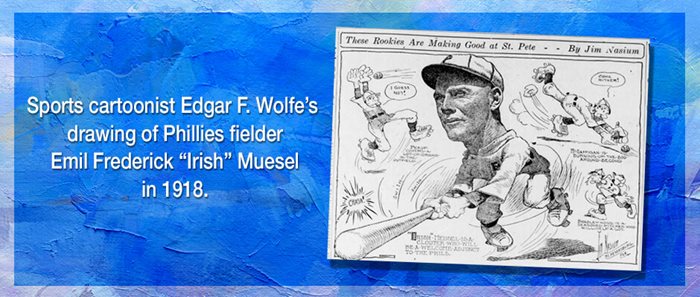
Charles Kwalwasser (1915), known around town as Charlie Kaye, was a comedian and dancer in his youth before he found his real niche – designing uniforms. From waitresses at department store restaurants to hotel bellhops and church ministers, many Pittsburghers wore garments fashioned “by Kaye.” Kwalwasser attended art and design schools in both Pittsburgh and New York City. He joined Kaufmann’s in 1935 in a department that specialized in designing uniforms. While at Kaufmann’s, he created uniforms for employees at the H.J. Heinz Company. In 1951, he opened his own small business, Artcraft Uniform Company, on Penn Avenue. He was the uncle of acclaimed violin soloist Helen Kwalwasser.
The Scalp Level School
The Scalp Level School painters were a group of Pittsburgh-area artists who visited and painted landscapes inspired by the natural beauty of the area around Paint Creek in Cambria County, Pennsylvania. Starting in the late 1860s, every summer, for the next several decades, the location hosted dozens of artists clad in straw hats and toting shade umbrellas and sketching stools.
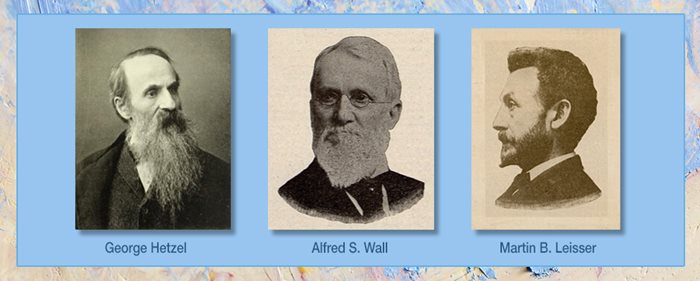
Among the Scalp Level artists who were Dollar Bank customers were:
George Hetzel (1866) was a European-born painter who founded the Scalp Level School.
Alfred S. Wall (1864), from Westmoreland County, was one of several artists in his family.
Pittsburgh native Martin B. Leisser (1884), a second-generation Scalp Level School painter, was known as “the dean of Pittsburgh artists.”
J.J. Gillespie & Co.
No discussion of the early arts community in Pittsburgh would be complete without acknowledgement of the firm of J.J. Gillespie & Co., the oldest art gallery in America. Before the inception of public art galleries in Pittsburgh, J.J. Gillespie & Co. filled the role of a gathering place for artists and exhibitions of their works.
As an 1868 Pittsburgh newspaper put it, J.J. Gillespie & Co. was the “art headquarters of Western Pennsylvania.” The firm bought and sold fine works of art, managed exhibitions in locales other than its own, advised wealthy Pittsburghers on building their art collections, and was one of the first stops for out-of-town portrait painters when they arrived in Pittsburgh on assignment to capture the likenesses of the city’s industrialists.
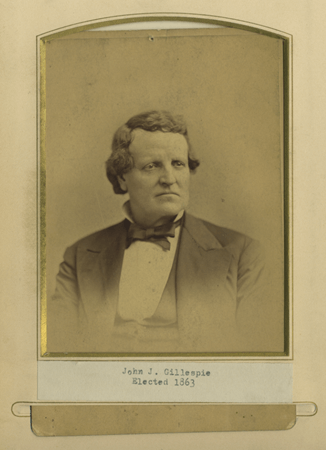
The namesake of the firm, John Jones Gillespie (1816-1886), was born in Milton, Pennsylvania. He arrived in Pittsburgh in 1831 and took a job as a clerk with Vorhees & Barche, a looking-glass and notions shop, on Wood Street. He became a partner in the firm in 1838 and eventually its proprietor. Gillespie expanded the store’s offerings from looking-glasses to paintings, engravings and other works of art. The company published the first lithograph west of the Alleghenies, and in 1845 began offering the services of framing, gilding and picture restoration.
A painting by self-taught African American artist Robert S. Duncanson, “Cliff Mine, Lake Superior” (1848), was exhibited at J.J. Gillespie & Co. in 1852. The work had been commissioned by Methodist minister and Pittsburgh abolitionist Charles Avery.
While Gillespie made annual trips to Europe to bring back art treasures from that continent, he encouraged and supported local talent. He was on the exhibition committee of the Pittsburgh Art Association, which held its first show in January 1860; was a friend of social realist painter David Gilmour Blythe (1815-1865), who illustrated a storefront view of Gillespie’s Gallery on Wood Street; and opened his premises to exhibitions of paintings by artists from the Scalp Level School. In 1868, painter and art critic Alfred S. Wall joined J.J. Gillespie & Co. as a partner in the firm.
Gillespie lived in Evergreen Hamlet, a bucolic community in Ross Township, where he bought the former Wade Hampton house in 1867. He was married for nearly 52 years to Eleanor Moore Gillespie. The couple raised six children.
J.J. Gillespie was a Dollar Bank Trustee from 1863 through 1886.
Musicians
On January 1857, Austrian immigrant Fidelis Zitterbart, Sr., a violinist, conductor and composer, opened two savings accounts in trust for his sons, Fidelis Jr. and Henry. For 24 years, Zitterbart Sr. led the orchestra at the Pittsburgh Theatre (“the Old Drury”) at 310 Fifth Avenue. From 1867 through the mid-1870s, he conducted the orchestra of the New York Theater on Broadway in New York City.Fidelis Zitterbart, Jr. (1845-1915) became a nationally renowned composer, who wrote more than a thousand pieces for orchestras, ensembles and choruses. He was taught violin by his father and, at age 9, became a full-fledged member of the Drury Theater orchestra.
German musicians Nicholas and George Toerge were father and son. Both opened savings accounts at Dollar Bank in August 1862. The Toerges were one of the foremost musical families in Pittsburgh in the late 1800s. George Toerge ran a music store on Seventh Avenue in downtown Pittsburgh. He and his brother, Frederick, were violinists and orchestra leaders.
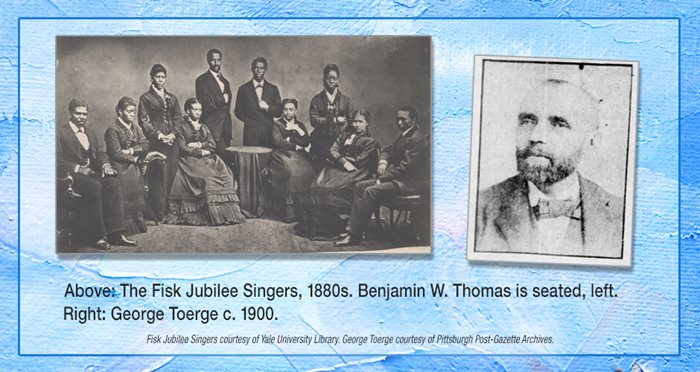
A member of Bethel A.M.E. Church, Benjamin W. Thomas (opened a savings account in 1872 with Dollar Bank) sang in the church choir. A professional musician, he sang bass with the Fisk Jubilee Singers and toured Europe with them in the 1870s. Later, he became musical director of two other African American spiritual singing groups, the Centennial Jubilee Singers and the Tennessee Jubilee Singers.
Slide trombonist Hubert Crispini (1888) was well-traveled. Born in Italy, he immigrated to the United States in the 1870s. He played under popular bandmaster Patrick Gilmore in Boston, as well as theater orchestras in that same city. Crispini moved to Pittsburgh in the late 1880s, but his musical career took him all over the United States and its territories. He performed in Honolulu, California, Colorado, Nebraska, South Dakota, Wisconsin and Ohio. He was also proficient on the violin and xylophone.
Otto Thorbahn (1889) was born in Canada and received his musical training at the Dana Music Institute in Warren, Ohio. He led the orchestra at the Duquesne Theatre in Pittsburgh, where he was also a music teacher. A versatile musician, he was proficient on many instruments, the clarinet being his favorite. In his later years, he became head of a music school in Lancaster, Pennsylvania.
Musician, composer and pianist Frank T. Thuma (1898) was a native of Buffalo, New York. A student of Fidelis Zitterbart, Jr., he assisted his sister, Margaret, and brother, Robert, in running the Thuma Dance Academy on Fourth Avenue. He shared a music studio, also located on Fourth Avenue, with fellow composer and music teacher Leo Oehmler. He played piano for the Haydn Trio Club and for a time managed the John S. Duss band.

Danny Nirella (1899) was an Italian immigrant who came to America as a youth with his parents and brothers. Known in Pittsburgh as “Mr. Music,” Nirella led several popular bands and orchestras. For nearly 50 years, he and his band played every season opener at Forbes Field for the Pittsburgh Pirates.
Jean Baptiste de Backer (1899) and William Pohle (1916) both served as president of Local 60, American Federation of Musicians. Belgian immigrant de Backer was an accomplished viola player who was a member of the Pittsburgh Orchestra under Victor Herbert. He also played violin with the Kunits Quartet, a string quartet named after violin virtuoso Luigi von Kunits.
Irish immigrant Victor Herbert (1900) conducted the Pittsburgh Orchestra for six years, from 1898 through 1904. He wrote the score for the stage musical, “Babes in Toyland,” while living on Aiken Avenue in Shadyside.
George Franklin Voerwerck (1909) studied for five years at the Royal Academy in Berlin. His teacher was Hungarian violinist Joseph Joachim. Voerwerck was musical director at the Harris Theatre. He played an Amati violin.
Stanis Alukonis (1921) was born in Lithuania in 1883. For 27 years, he was the organist at Ascension Church on the North Side.
Music Teachers
Edwin Sherratt (1871), an English immigrant who came to the United States as a child with his family in 1840, played the organ and directed a children’s choir at the Sixth Avenue Mission School of the Second Presbyterian Church. He also gave singing lessons to both children and adults and was a music teacher at Pittsburgh public schools. In the 1890s, he moved to Berkeley, California, where he became a music dealer and piano tuner.
Paris native Clement Tetedoux (1869) was widely recognized as one of the finest vocal teachers in the United States. He enjoyed a first-rate musical education in France, Italy and Russia, where his teachers included operatic tenor Marco Bordogni and composer Giuseppe Ceccherini. Tetedoux was a driving force behind the development of Pittsburgh’s early music community, both the training of professional musicians and the cultivating of music-loving audiences.
Tetedoux led Pittsburgh’s first-ever performance of Rossini’s “Stabat Mater” in April 1868 at the Academy of Music. The large-scale production, which called for a chorus of more than 50 singers and a 25-piece orchestra, required more musicians than Pittsburgh had musical professionals at that time. Undaunted, Tetedoux recruited eager amateurs, and pulled off a splendid performance. Rossini’s work was just one of many classics introduced to the city by Tetedoux and the Gounod Club, of which he was a founder.
Philip Dornberger (1880) came to Pittsburgh from Germany in 1866. In 1873 he returned to Germany to study music at the Leipzig Conservatory, winning the Helbig Prize during his three years there. When he came back to Pittsburgh, Dornberger became a music teacher at the Pittsburgh Female College.
Solo pianist and soprano singer Lily Frederick (1891) performed in concerts around Pittsburgh. She also taught piano and harmony at Curry University and was the head of the music department at Greensburg Seminary. She maintained a studio at 5546 Jackson Street in Highland Park. For decades, her students gave seasonal recitals at the Rittenhouse Hotel in East Liberty. A member of the Audubon Society, she provided in her will scholarships for graduates from Peabody High School.
Leo Oehmler (1894) was born in Pittsburgh. In addition to being well-known as a music teacher in his home city, he was also a violinist and composer of more than 300 works for violin and piano. He was hailed as a prodigy at age 6 when he displayed mastery of the violin. His sister, Clara, was a virtuoso pianist. They frequently performed together.

Oehmler, a graduate of Western University of Pennsylvania, studied music in Europe – the Royal Conservatory of Music in London and Stern Conservatory in Berlin. He was a part-time violin instructor at University of Wooster in Ohio. He maintained two teaching studios in Pittsburgh, one on Fourth Avenue, downtown, and the other on Craig Street in the East End. Among his composition students was American composer Charles Wakefield Cadmon. In his later years, Oehmler moved to Pasadena, California, where he became part of a small artists’ colony of Pittsburghers.
Born in Mt. Pleasant, Pennsylvania, Eva Mae Andrew (1911) was a piano teacher in Westmoreland County for many years in the early 1900s. She also taught music at the McCrum School (McCrum National Training School for Slovanic Young Women) in Uniontown, Fayette County, Pennsylvania.
Music Store Owners
John Zweidinger (1855) ran a music store on Smithfield Street, near Sixth, where he sold pianos, cabinet organs and melodeons. Piano tuner Jacob Schoenberger (1872) was born in Germany. His music store, Lechner & Schoenberger, was located on Fifth Avenue in downtown Pittsburgh.
One of the most successful music stores in early Pittsburgh was Mellor’s, a downtown institution for more than 120 years. Founded in 1831 by John H. Mellor, the store was run by the Mellor family for four generations. English immigrant John H. Mellor was a Dollar Bank Trustee for more than 30 years. His son, Charles Chauncey Mellor, became a Dollar Bank depositor in 1857. Charles C. Mellor was also a musician, playing the organ at First Presbyterian Church on Wood Street for 22 years. A patron of all the arts, not just music, Mellor was a member of the Scalp Level School of painters.
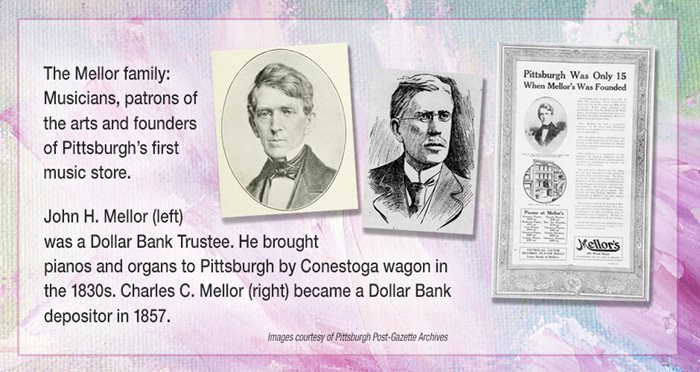
Entertainers
Actors, comedians and entertainers performed for Pittsburgh audiences in the early 1800s. The city’s first free-standing playhouse, the Theatre on Third Street, once occupied land that is now part of Dollar Bank’s Fourth Avenue property.Theatrical performers traveling through Pittsburgh sometimes opened savings accounts at Dollar Bank to ensure the safekeeping of their money while their productions were engaged here. The performance runs usually lasted several weeks. Two comedians were among Dollar Bank’s earliest customers in 1855 – Alfred William Young and Thomas Ulliam. Actress Amelia Butler (1860) performed in New York and Baltimore the same year her theater company played in Pittsburgh.
Actor Greenbury Carr Germon (1867, 1868), who was born in Lowell, Massachusetts, came from a theatrical family. Both his parents were actors, as were his maternal grandmother, two siblings, and at least one cousin. Germon performed at the Opera House on Fifth Avenue during his 1868 tour of Pittsburgh.

Among the notable roles played by Irish-born actress Augusta Dargon (1871) were the ill-fated Mary, Queen of Scots, Shakespeare’s Lady Macbeth, and Camille, the tragic heroine of Alexandre Dumas’ novel and stage play. Noted for her wit and charm, Dargon was an audience favorite everywhere she performed. She traveled through Pittsburgh on several occasions from 1868 through the 1870s. In October 1871, she was playing an engagement in Chicago when the Great Fire broke out, and she narrowly escaped harm in the disaster. In 1880, during a tour of Australia and New Zealand, Dargon met and married an Australian cattle rancher and retired from the stage.
Robinson House, on the corner of Seventh Street and Duquesne Way, was where five actors lodged when their theatrical group came to Pittsburgh in September 1874. Henry Wilson, John Smith Marble, William Florence Owen, Sidney S. Hicks and Walter Standish all opened savings accounts with Dollar Bank.
John M. Miller (1882) was a tightrope walker who came to Pittsburgh just weeks before showman P.T. Barnum brought his “greatest show on earth” to the city.
Magician Amos Zimmerman (1884) and actress Edith Smithson (1886) were both born in Pittsburgh. Smithson was an amateur actress and director who performed with community theater productions in Mt. Washington. She later married Thomas W. Williams, who worked as a bookkeeper for Dollar Bank for 52 years.
Pittsburgh’s flourishing theatrical scene in the late 1800s and early 1900s brought jobs and opportunities to many musicians, entertainers and theater staff. At least three theater managers were Dollar Bank depositors in this era – Walter P. Dean (1891), manager of the Harris Theater; Richard M. Gulick (1898) of the Bijou Theatre; and the Gayety Theatre’s Henry Kurtzman (1909).
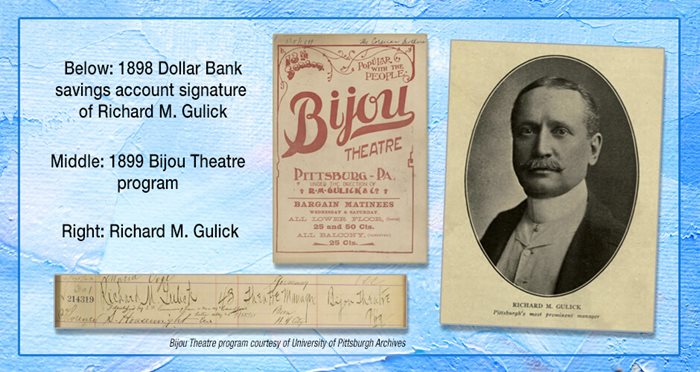
Born in Brooklyn, Gulick started in the entertainment business in 1885 as a partner in the purchase of Liberty Hall. Gulick and his partner remodeled the place and reopened it as the Bijou Theatre in September 1886. Under Gulick's skilled management, the Bijou became one of the most successful and desirable performance spaces in Pittsburgh.
African American vaudeville performer Ellis Harrison Graves (1910) was billed as a mimic and “the world’s greatest whistler.” Born in Virginia, he moved to Pittsburgh as a youth with his family. His sister, Nellie A. Graves, was a lyric soprano and pianist. The siblings sometimes performed together, usually at church concerts. Both were members of Ebenezer Baptist Church. Ellis H. Graves played the Zimmerman Vaudeville Circuit in Ohio and also performed in Indiana and Michigan. Nellie Graves sang on KDKA Radio in 1922.
Hollis Edison Davenny (1911) was a Western Pennsylvania native. Born in Greenville in Mercer County, he moved to Pittsburgh as a youth and studied violin under Leo Oehmler. Davenny attended Carnegie Tech, where he was the musical director of the school's student orchestra. He briefly toured the country with the Davenny Quintet in 1917, performing in the musical “Bohemian Girl.” The following year, he served in the U.S. Army’s Quartermaster Corps. He led a military choral group.

One of many lured by the bright lights of Broadway, Davenny moved to New York around 1920 after his discharge from the army. It didn’t take long for him to get his big break. Davenny was cast as composer Franz Schubert in the musical “Blossom Time” and earned enthusiastic reviews for his performance. Gifted with an uncanny resemblance to the composer, Davenny also possessed a solid background in classical music, a smooth baritone voice and sharp acting skills. He became the lead in the touring company of “Blossom Time” in 1922, playing to packed houses in cities across the United States and Canada.
Davenny moved to Southern California after the touring production wrapped. He continued performing in theater, starring in Sigmund Romberg’s “Student Prince,” and became the district musical chairman of the Kiwanis Club.
Carl Berndle listed his occupation as “fancy ice skater” when he opened a savings account with Dollar Bank in 1918. Two years earlier, at age 18, Berndle had won the Western Pennsylvania figure skating championship. In 1917, he performed at Duquesne Garden and became known as the “Spinning Wizard” for his showmanship. Berndle served in the U.S. Army in WWI and stayed active in skating for decades, performing with his wife, Josephine A. Berndle.
Pittsburgh-born Charles A. Hutchison (1920) became a silent film star in Hollywood as a daredevil stuntman and lead in action-adventure serials.
Photographers
Daguerreotype artist William P. Hatfield opened a savings account with Dollar Bank in February 1862. A photographic process invented in France by Louis Daguerre, the daguerreotype recorded an image on a light-sensitive silver-plated copper surface.Pennsylvania-born Samuel S. Pollock (1862) and Thomas McBride (1864) were both photographers who worked in the city. McBride’s studio was in East Birmingham, one of the four boroughs that made up what is now Pittsburgh’s South Side.
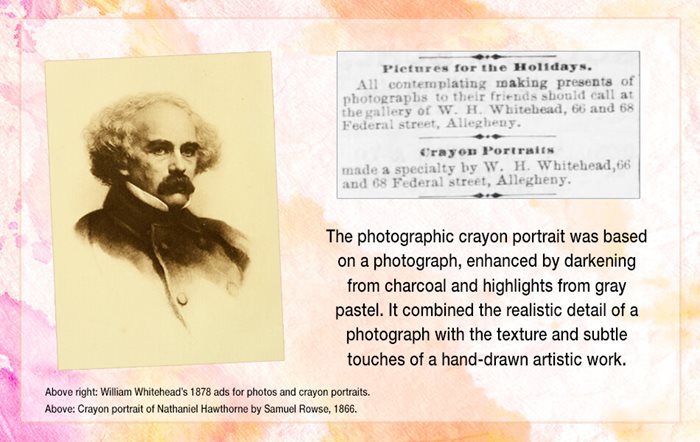
William H. Whitehead (1867) was born in Virginia. He learned photography as a boy, serving as an apprentice at age 12, and took over the studio of his mentor, Robert Rogers, when the latter retired. Whitehead ran this downtown studio for 35 years and opened a second studio in McKeesport, which he owned for 30 years. In his 1920 obituary, he was credited with having made the first photo portrait of Pittsburgh.
Although he listed his occupation as “artist,” Joseph B. Alexander (1868) maintained a photography studio on East Carson Street in the South Side for 30 years. A Civil War veteran and POW who survived Libby Prison, Alexander was a member of several veterans’ organizations. He and his wife, Katharine, raised six children. His oldest son, Benjamin, became a photographer, and his daughters Laura and Lottie worked as a teacher and bookkeeper, respectively.
Cincinnati native James R. Pearson (1871) also served in the Civil War, in the Union Navy. He was a member of a Mississippi River squadron under the command of John Rogers. After the war, he started his photography business in Allegheny City (North Side), then opened a second studio on Fifth Avenue in downtown Pittsburgh. He was one of the most in-demand crayon portrait artists in the city.
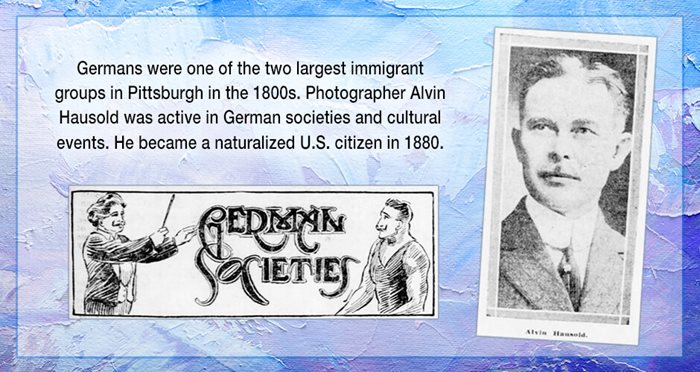
An immigrant from the Saxony area of Germany, Alvin Hausold (1880) owned an art and photography studio on Federal Street in Allegheny City. Hausold, a music lover, was an amateur composer and singer, participating in concerts celebrating German classical music and folk songs, in an era when Germans were one of the largest immigrant groups in the region. He served as director, secretary, vice president and president of Gesangverein Frohsinn, a German singing society founded in 1851, and competed with them in saengerfests (singer festivals) all over Pennsylvania. He lived in Ben Avon with his wife and their three daughters.
The first job David Rosser (1888, 1896) had as a youth was in a tack factory. He lasted three days. After that he obtained apprenticeships with local photographers Paul Fallert and James R. Pearson. Rosser bought out the studio which famed New York photographer Edward Carey Dana maintained in Pittsburgh and proceeded to make a handsome living as a portrait photographer at 347 Fifth Avenue. He lived in Carrick, where he was a member of the volunteer fire department.

Rosser was dedicated to advancing both the artistic and technical aspects of his profession. His photos won awards at state and national exhibitions. He was a member of the Photographers’ Association of America and served as both secretary and president of the Photographers’ Association of Pennsylvania. In 1900, he and O.H. Smith set a world record for the fastest finished photograph, from exposure to print, a process they completed in 8 minutes and 24 seconds. Rosser shot the 1901 team portrait of the pennant-winning Pittsburgh Pirates.
Ernest Walter Histed (1893) was known as “the van Dyck of photographers.” His exquisitely lit portraits, the subjects of which ranged from author Mark Twain to Henry Clay Frick to composer Camille Saint-Saëns, were acclaimed for their beauty and detail.
Claude Constant Laval, also known fondly as Pop Laval, opened a savings account at Dollar Bank in August 1909, listing his occupation as commercial photographer. Born in New York City, Laval resided in Pittsburgh for nine years before moving to Fresno, California in 1911. There he would remain for the rest of his life, becoming a local legend and shooting some 100,000 still photographs, movies and aerial survey photos over the next 55 years.
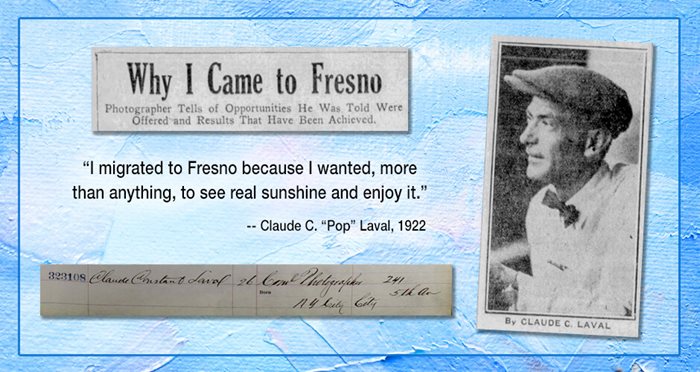
Laval documented the people, workers, civic life and development of Fresno and the surrounding area. The San Joaquin Counties Association hired him as its official photographer in 1914. His photos were exhibited at the Panama-Pacific International Exposition in San Francisco the following year. As the San Joaquin Valley’s foremost commercial photographer, he incorporated his business in 1922 as the Laval Company.
One of the most successful portrait photographers in Pittsburgh in the late 1800s was Benjamin Lomax Horsely Dabbs (1839-1899), known professionally as B.L.H. Dabbs. Born in London, England, he immigrated to the United States as a child with his parents. His father, George Dabbs, ran a photographers’ supply store in New York City. The younger Dabbs had a talent for drawing.
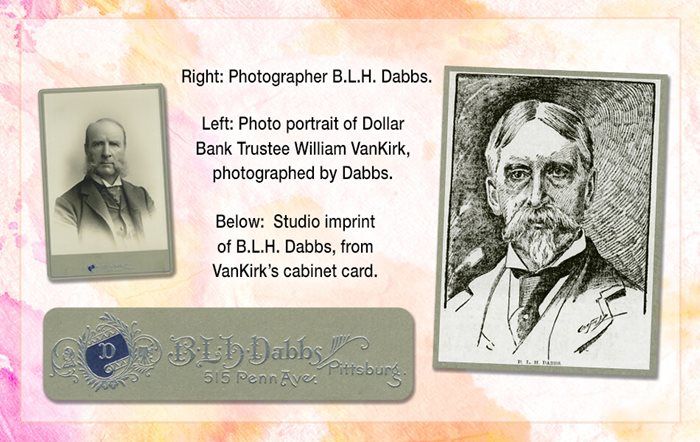
In April 1861, B.L.H. Dabbs moved to Pittsburgh, setting up a branch store of his father’s business. He did this for about a year, then opened his own photography studio. Among his many clients were scores of prominent Western Pennsylvanians, including several Trustees of Dollar Bank and industrialist Andrew Carnegie. Dabbs was a member of the Photographers’ Association of America and president of the Professional Photographers’ Club of Allegheny County. He was a friend of fellow photographer David Rosser.
Married three times and twice widowed, Dabbs had nine children and lived on North Highland Avenue.